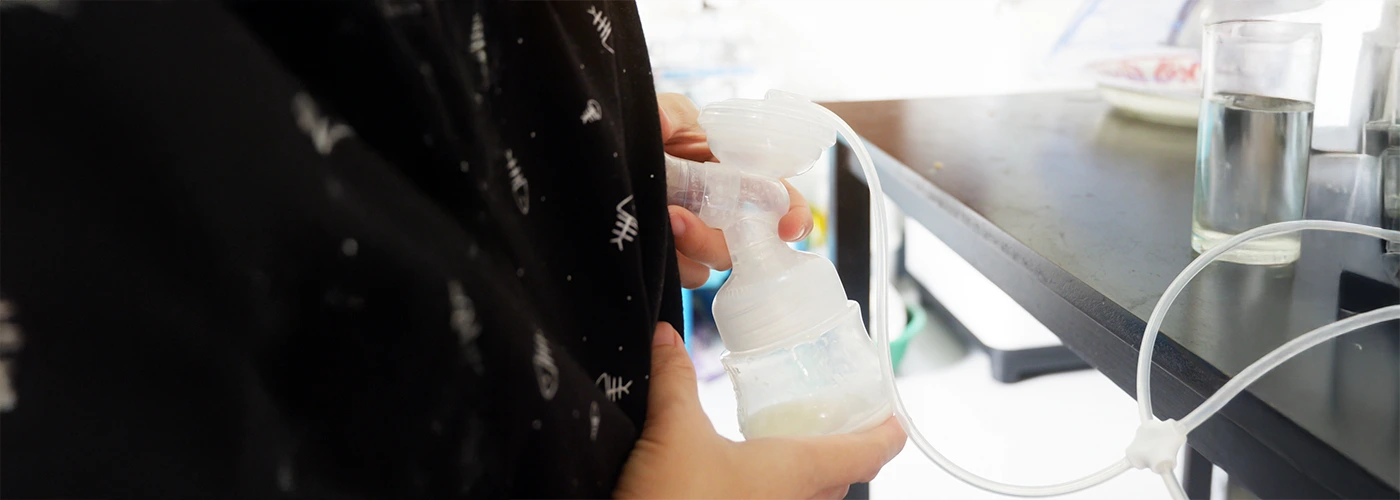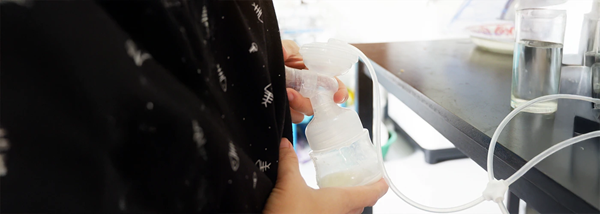Topics
What is a breast pump?
A breast pump is a device that helps nursing mothers express milk for their babies. Whether you are a working mom, facing medical challenges, or simply seeking some flexibility, understanding what a breast pump is and how to use it can be a game-changer.
Lactating mothers use the breast pump when they cannot breastfeed their babies due to premature birth or having latching difficulties. It also allows mothers to store breast milk for later use, ensuring their babies receive vital nutrients and antibodies even when direct breastfeeding is not possible.
Beyond convenience, breast pumps also offer relief from engorgement and help maintain a consistent milk supply. As a testament to modern innovation, they bridge the gap between a mother’s commitment to breastfeeding and the challenges of everyday busy lives.
What are the parts of a breast pump?
A breast pump contains three major components — a breast shield, a pump, and a milk container for collecting the milk.
- Breast shield or flanges: This part covers the nipple. The breast shield is cone-shaped and comes in different sizes. Hence, it is advisable to get the one that fits you. If it is too small, it can reduce the amount of milk you express or lead to sore nipples. On the other hand, if the shield is too big, the areola may get into the funnel, and the suction can cause pain while pumping.
- Pump or pumping tube: This part connects the breast shields and the collector bottles. The pump creates the suction effect or vacuum that expresses the breast milk.
- Milk container or collector bottles: The expressed milk from the breast goes into the milk container. The bottle is easily detachable to transfer the expressed breast milk to another storage container.
What are the types of breast pumps?
Breast pumps come in various types, each catering to different needs.
- Manual breast pumps: These are lightweight and portable, perfect for occasional use. They come with a lever you can pull to stimulate the milk flow from your breasts.
- Electric breast pumps: Electric pumps provide efficient and adjustable suction, making them ideal for regular use. These pumps are attached to an electric stimulator.
- Battery-powered breast pumps: This is similar to an electric pump but is more convenient for mothers on the move or who want to multitask. It comes with rechargeable batteries and is easily portable.
- Hospital-grade breast pumps: These pumps are rentable and designed for lactating mothers whose babies have certain medical conditions like feeding difficulties due to premature births. The hospital-grade breast pump has strong suction strength, increasing milk production and flow.
Pumping types
- Single pumping type: The single breast pump involves expressing milk from one breast at a time. This type takes more time, especially since they are common with manual breast pumps.
- Double pumping type: The double breast pump is more popular among working mothers. It involves expressing milk from both breasts at once. The type is common with electric pumps and saves time.
What are the benefits of using a breast pump?
Beyond their primary function of milk extraction, a breast pump also provides the following benefits:
- Convenience to feed your baby at any time.
- Maintaining a consistent milk supply.
- Allows partners and caregivers to participate in feeding, strengthening familial bonds.
- Convenience for working mothers who can continue breastfeeding while at their jobs.
How to choose the best breast pump for you?
Consider the following factors before you make your pick:
- Frequency of use: Different breast pumps are designed for different usage frequencies. Consider how long and how often you want to pump milk each day. It could be for occasional use, daily pumping, or exclusive pumping.
- Portability: Consider the size, weight, and power source of the pump. Can you easily move around or multi-task with it? Can you use it at work or while travelling? Manual pumps are often suitable for carrying around but not for multitasking. On the other hand, battery-operated pumps are often small and portable, making them more suitable for busy women.
- Personal comfort: Ensure that your selected breast pump does not cause pain or discomfort while expressing milk. Go for the breast pumps with adjustable breast shields.
- Price: Consider your budget. Go for the breast pump that optimises affordability and quality.
How to use a breast pump?
Mastering a breast pump can be a game-changer for many mothers, ensuring flexibility without compromising their baby’s nutrition.
1. Preparation
- Thoroughly wash your hands and the pump with soap and enough water. You can sterilise all parts of the pump to ensure there are no underlying specks of dirt. Contaminated milk can affect your baby and cause health complications.
- Follow the manufacturer’s instructions to assemble various parts.
- Find a comfortable and quiet place to pump. Try not to express breast milk when you are stressed as it may affect your milk flow.
2. Positioning
- Properly position the breast shield. Ensure the breast shield is centred over the nipple. Since it is cone-shaped, it should be easy to balance it. Remember, the shield should adequately fit around the nipple and should not be too big or too small.
- Adjust the breast shield if necessary. If the initial size is uncomfortable, you can adjust it to fit your nipple size.
3. Pumping
- Do not start the suction at full speed. The sudden pace can cause pain or damage breast tissue, especially if you use an electric pump. Low suction stimulates the breast to allow the milk to flow easily. Increase the speed gradually.
- Gently massage your breasts during the process to help stimulate milk flow and improve pumping efficiency.
- Pumping one breast for too long can cause discomfort. Switch between breasts every 5-10 minutes. If you are using the double-pumping style, you can pause at intervals.
4. Storage
- Store the expressed milk in clean and sterilised containers. You can use either bottles or breast milk storage bags.
- Label each container with the date and time when the milk was pumped to remind yourself to use the oldest milk first.
- Follow guidelines for milk storage durations in the fridge, freezer, or room temperature. You can ask your lactation consultant for suitable storage suggestions.
Read more: Proper Breast Milk Handling and Storage Guideline
How to clean and maintain a breast pump?
After you have pumped the desired quantity of breast milk, carefully dismantle the pump before you start cleaning. It is easier to thoroughly clean each part of the breast pump when they are disassembled.
Focus more on cleaning the parts that contact the milk. Consider the following tips when cleaning your breast pump parts:
- Add water and soap into a clean wash basin to soak the separated parts.
- Carefully but thoroughly scrub each pump part according to the manufacturer’s instructions.
- Rinse in clean water so the dirt and soap are properly washed off.
- Turn them upside down to drain off the water and allow them to air dry. Using a towel to dry them off can introduce some new germs to the parts.
Is it safe to use a breast pump daily?
Using a breast pump daily is generally considered safe for most mothers, provided they follow proper hygiene practices and use the device as per manufacturer guidelines.
You can pump for 10 to 25 minutes, depending on how fast the bottles fill. Regular pumping can even be beneficial for maintaining a consistent milk supply, especially for mothers who are separated from their infants or are returning to work. However, you should only pump for a maximum of 30 minutes at a time to prevent the breast tissue from becoming sore.
It is essential to ensure comfort, avoid over-pumping, and consult a lactation expert or paediatrician if any concerns arise.
Read more: How Frequently Can I Pump Breast Milk
What are the common challenges and solutions when using a breast pump?
- Difficulty expressing milk: This can be due to incorrect pump settings, discomfort, or stress. Ensure that you get a breast shield that fits appropriately. Also, try different relaxation methods to ease stress and anxiety.
- Pain or discomfort while pumping: You may experience some pain or discomfort if the suction setting is too high, if the nipple is too sensitive, or when there is engorgement. Engorgement happens when the breast is too full of milk and causes pain. For sensitive nipples, consult your gynaecologist first for directions on what to do.
- Issues with milk supply: Low milk supply can be a concern. However, dietary and lifestyle changes can help improve the situation. Hydration, nutrition, and relaxation techniques may positively impact milk supply. Remember to seek advice from your lactation consultant if the issue persists.
Make an appointment at Pantai Hospitals
For expert guidance and support on breastfeeding and pumping, do make an appointment with the team of Consultant Paediatricians and Lactation Consultants at the nearest Pantai Hospital to you today.
Pantai Hospitals have been accredited by the Malaysian Society for Quality in Health (MSQH) for its commitment to patient safety and service quality.
This article has been medically reviewed by Consultant Paediatrician and Neonatologist, Dr Livia Chow Huey Ling.













